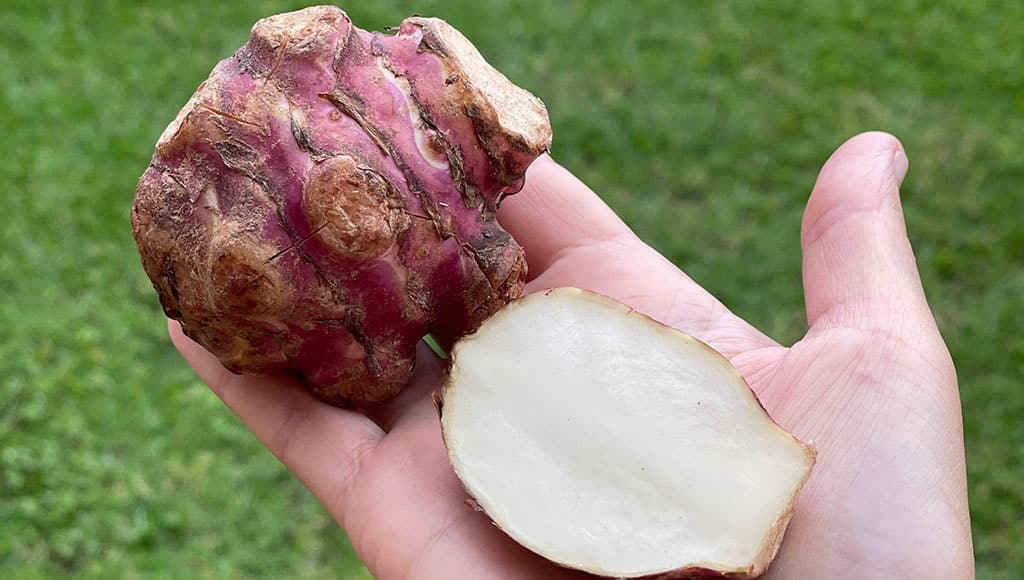More often than not, when we find ourselves at the vegetable stalls in the market, we opt for the familiar and habitual. Week after week we buy the usual vegetable basket, anticipating cooking the old-time favourites.
However, at times, as if possessed by an unknown spell, we go astray and venture into the unknown side of the isle. Similar to the Fangorn forests of the Lord of the Rings saga, here it feels eerie and mysterious.
We are greeted by inhabitants of lesser-known shapes and colours, and even lesser known flavours. Each vegetable looks odd in its own way, but what catches the eye is a purple, knobbly potato. It is firm to the touch and exudes a slight tinge of sunflower fragrance. “Jerusalem artichoke” – exclaims the seller – “it is not an artichoke, nor is it from Jerusalem”.
Whilst the artichoke part of the name reflects the similarity in flavour and texture with a common artichoke, the Jerusalem part comes as a result of decades of confusion and mispronunciation.
Having arrived in Europe with Iberian explorers from Americas, Jerusalem artichoke is a tuber, akin to potato, but is also a member of the sunflower family, Helianthus tuberosus. This similarity earned it the name Girasole Articiocco, that was based on Latin for sunflower.
The fact that this vegetable was handed out from the garden of Cardinal Farnese, a favourite of the Pope, who was growing them in Rome in 1617, has infused it with some wishful divine associations.

As a consequence of this, and in combination with the decades of slur and stutter, the word girasole transformed into Jerusalem.
Interestingly, the French name of the vegetable, topinambour, also derives from confusion. In 1613, several members of the Brazilian tribe, the Tououpinambaoults, were introduced to the king’s court, right when our glorious vegetable made an appearance too. The court assumed the exotic tubers were Brazilian and started calling them topinambours. Amongst French, the vegetable gained great popularity in the 18th and 19th centuries, when a chef called Louis-Eustache Ude used them for a Palestinian soup that is still a staple in many French homes.
Similar to potatoes, there are multiple varieties of Jerusalem artichokes. Some are smooth, whereas others are more lumpy; some have light-beige skins, whilst others are purple. Inside, there is a crisp, juicy and sweet ivory flesh that transforms into a chestnut’s flavour when cooked.
Unlike potatoes, they don’t contain starch but inulin, which makes it a perfect choice for people with diabetes. At the same time, overindulgence is not recommended as it is known to cause digestive discomfort for some.
Whilst there are many ways of deploying Jerusalem artichoke in the kitchen, for instance soups, gratins or simple oven-roasted, my favourite is to use it as an additional layer of flavour in what could be a familiar dish.
For example, fold it into a pearl barley risotto or a regular kind for an extra oomph. To do that, roast the cleaned and cubed knobs in the oven with a generous amount of garlic, thyme and olive oil. Pureé it all together in the blender with a bit of butter, milk or cream for a smooth, creamy consistency. Add it to the risotto or ‘pearlotto’, and serve with seafood, particularly scallops or langoustines. The sweetness of the artichokes is a match made in heaven for seafood or fish.
By Dr. Irina Mikhailava
|| features@algarveresident.com
Dr. Irina Mikhailava, a chef and a good food champion, happily residing in the Algarve and eating all over the world with an appetite for learning, sharing and writing. Instagram: incompanyoffood




















